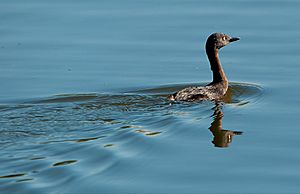New Zealand grebe facts for kids
Quick facts for kids New Zealand grebe |
|
|---|---|
 |
|
| Conservation status | |
| Scientific classification | |
| Genus: |
Poliocephalus
|
| Species: |
rufopectus
|
The New Zealand grebe, also called the New Zealand dabchick or weweia, is a special bird found only in New Zealand. It belongs to the grebe family.
Contents
What Does the New Zealand Grebe Look Like?
The New Zealand grebe has dark brown feathers. It has a small black head with shiny silver feathers and bright yellow eyes. Its beak is black and pointed.
This bird grows to about 29 centimeters (11 inches) long. It weighs around 250 grams (about half a pound). When they are not breeding, their feathers are lighter. Female grebes are usually a bit smaller and lighter than males. They also have a slightly shorter beak.
Where Do New Zealand Grebes Live?
These grebes mostly live in shallow freshwater places. This includes lakes, ponds, and calm inlets.
Today, you can mostly find them in the North Island of New Zealand. They live in coastal lakes on the west side, from North Cape down to Pukekohe. You can also find them from Southern Taranaki to Paraparaumu. They also live in ponds on the Volcanic Plateau, in Gisborne, Hawkes Bay, and the Wairarapa.
Long ago, these birds also lived in the lowland lakes of the South Island. But their numbers quickly dropped in the 1800s. No one knows exactly why. The last time they were regularly seen breeding in the South Island was in 1941. However, in 2012, a pair bred near Takaka. This was the first time in many years!
How Do New Zealand Grebes Behave?
These birds are freshwater divers. They usually fly only at night. During the day, you will always see them in the water. They swim on the surface and often dive to find food.
If they feel unsafe or are bothered during the day, they don't fly away. Instead, they swim or dive to escape. In autumn and winter, they often gather in groups. But during the breeding season, they usually stay in pairs. They are very protective of their territory. They will make short calls if they feel threatened or during the breeding season.
What Do New Zealand Grebes Eat?
The New Zealand grebe's diet is mostly made up of water insects and their young (larvae). They also eat small snails from freshwater. Sometimes, they will eat bigger prey like fish or freshwater crayfish.
Their short, pointed beak is perfect for eating insects. They catch their food by diving underwater. They can also pick food right off the water's surface.
New Zealand Grebe Life Cycle and Reproduction
The breeding season for these grebes is from June to March. On average, a pair will lay 2 to 3 eggs. Both the male and female take turns sitting on the eggs. This incubation period lasts for 22 to 23 days.
Their nest is usually built from plants found nearby. This includes floating plant material. When the chicks hatch, they are quite developed. They can swim and dive right away, even though they can't fly for the first few weeks. Both parents help raise and feed their young. They care for them for up to 70 days after they hatch. Young chicks have stripes on their head and neck. Their beak is black until they grow their adult feathers.
Conservation Efforts for the New Zealand Grebe
The New Zealand grebe is a bird found only in New Zealand. Today, it lives only on the North Island. In 1994, the IUCN said the New Zealand grebe was an Endangered species. This meant it was at high risk of dying out.
But thanks to conservation work, like managing their habitats, their numbers have grown! The population is now around 1,900 to 2,000 birds. Because of this success, the IUCN changed its status in 2016 to Near Threatened. This means they are still at risk, but less so than before.
Human activities have actually helped these birds. Things like farm dams and ponds made for farm animals have created more places for grebes to live. So, even though their population is still small, it is not decreasing anymore.
See also
 In Spanish: Zampullín maorí para niños
In Spanish: Zampullín maorí para niños



